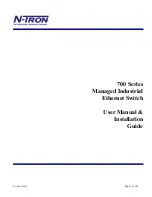
Chapter 4. Web Configuration & Operation
286
CHAPTER 4
WEB OPERATION & CONFIGURATION
Delay Min.:
The minimum delay - since last 'clear'. The unit is microsecond.
Delay Max.:
The maximum delay - since last 'clear'. The unit is microsecond.
Average Variation last N:
The average delay variation of the last n packets - since last 'clear'. The unit is microsecond.
Average Variation Min.:
The minimum delay variation - since last 'clear'. The unit is microsecond.
Average Variation Max.:
The maximum delay variation - since last 'clear'. The unit is microsecond.
Overflow:
The number of counter overflow - since last 'clear'.
Clear:
Click the checkbox and save this setting will clear the accumulated counters.
4.3.16 ERPS
Ethernet Ring Protection Switching (ERPS), defined in ITU-T G8032, implements protection switching mechanism for
Ethernet traffic in a ring topology. By performing ERPS function, potential loops in a network can be avoided by
blocking traffic to flow to ring protection link (RPL) so as to protect the entire Ethernet ring.
In a ring topology that runs ERPS, only one switch is assigned as an owner that is responsible for blocking traffic in RPL
so as to avoid loops. The switch adjacent to the RPL owner is called RPL neighbor node that is responsible for blocking
its end of the RPL under normal condition. Other participating switches adjacent to RPL owner or neighbor in a ring
are members or RPL next-neighbor nodes to this topology and normally forward receive traffic.
Nodes on the ring periodically use control messages called Ring Automatic Protection Switching message to ensure
that a ring is up and loop-free. Once RPL owner misses poll packets or learns from fault detection packets, RPL owner
detects signal failure (SF) in a ring. Upon learning of a fault, the RPL owner unblocks ring protection link (RPL) allowing
protected VLAN traffic through.
ERPS, like STP, provides a loop-free network by using polling packets to detect faults. However, when a fault occurs,
ERPS heals itself by sending traffic over a protected reverse path instead of making a calculation to find out the
forwarding path. Because of this fault detection mechanism, ERPS can converge in less than 50 milliseconds and
recover quickly to forward traffic.
ERPS ID:
Specify an ID for this group.
Port 0:
Port 0 is also known as E port (East port) which is used by some of the other vendors. Specify the east port of
the switch in the ring.
Port 1:
Port 1 is also known as W port (West port) which is used by some of the other vendors. When this port is
interconnected with the other sub-ring, “0” is used in this field to indicate that no west port is associated with this
instance. Specify the west port of the switch in the ring.
Port 0 APS MEP:
Specify the East APS PDU handling MEP.
Port 1 APS MEP:
Specify the West APS PDU handling MEP. When interconnected with the other sub-ring, “0” is used in
this field to indicate that no west APS MEP is associated with this instance.
Port 0 SF MEP:
This is also known as East Signal Fail APS MEP. Assign the East Signal Fail reporting MEP in this field.
Summary of Contents for MSW-4424C Series
Page 1: ...1 MSW 4424C MSW 4424CS L2 Gigabit Carrier Ethernet Switch ...
Page 382: ......
















































